As someone who’s dabbled in low-fare finding for a while now, I’ve long felt I had a fairly good grasp of all the major airfare search engines out there. So there’s nothing quite like finding out about a new flight discovery tool, nearly two years late, to put me back in a more humble place.
Hopper.com was actually founded in Montreal over 7 years ago back in 2007. But for the first 6 years of its existence, Hopper operated in stealth mode (whatever that means) as its team of former-Expedia-and-TripAdvisor engineers carefully built out what it now claims is the “world’s largest structured database of travel information.”
So what does Hopper do with all this data?
The way I see it, Hopper scrapes fare information from blogs, forums, and perhaps more proprietary sources like booking sites and feeds all this data into three main “products,” at least from the consumer-side.
Let’s start with the least exciting product, because I think this somehow makes things more fun to discuss.
Flight Explorer
This is Hopper’s “Flight Explorer” tool, which apparently displays how much it’ll cost to get anywhere from somewhere.
Obviously, the value of such a tool would be in narrowing your search to only include under-priced fares and figuring out how to book them.
But if you thought that this functionality kind of sounded like Airfare Watchdog’s “Best Fares From a City” tool, you’d be right! Because that’s all Flight Explorer appears to be. I admit there’s something to be said for integrating more powerful features like being able to search multiple airports at once, but at its core, this product doesn’t seem all that groundbreaking.
Let’s move on:
Deals
At first, “Deals” just looks like what you might find on The Flight Deal and other low-fare blogs wrapped up in a neat user interface. I like well-designed things, so this alone would be reason enough for me to start using Hopper.
But as you continue to explore the site’s features, it becomes clear that Hopper is a whole lot more than a pretty face.
Consider this fare detail page for Nedumbassery, India:
Besides introducing me to a city with quite possibly the most badass name ever, Hopper displays some surprisingly detailed information about fares available to Nedumbassery. For example, not only does it show what the lowest fare was, it informs me that the lowest fare available now is currently $888.
But Hopper goes on to reassure me that $888 is still 10% cheaper than average for this route. Minus one point for not displaying this adjusted fare on the previous summary page, but plus 100 points for being able to import live fare data like that.
After some math that was way harder than it should have been, I presume this means that the average price for this route is about $986. I’m not sure why Hopper doesn’t just say that instead of throwing similarly detailed but now-irrelevant data (“up to” X% lower than normal prices saving me $Y) – especially when the original low-fare is ostensibly no longer available.
But I digress.
To continue, I click “Shop Flights” to explore any means of transporting myself to the strange new world of Nedumbassery:
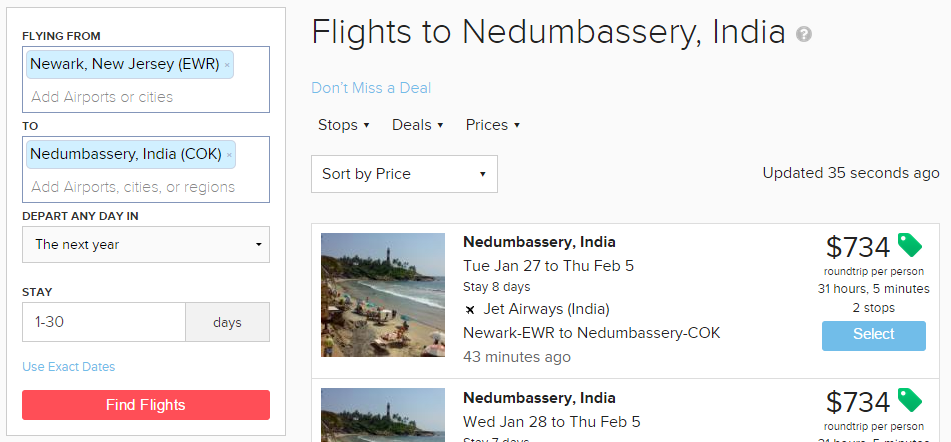
Hey, this looks familiar. It’s the “Flight Explorer” page I kind of ragged on earlier. I see you now, ex-Expedia/TripAdvisor engineers. Sorry for doubting you.
But it’s weird that this page shows fares available at $734 even though the previous page warned that the lowest fare had increased to $888. $734 is even lower than the initially-low fare of $759!
As you may have already noticed, it’s further alleged that this mysteriously-low $734 fare is available on Jet Airways as opposed to the earlier-cited Air India Limited, which adds another layer of contradicting complexity to this whole situation.
Who am I to believe? Which is truth? What is real? Only one way to find out.

After selecting the first available flight, I am indeed brought directly to Jet Airways‘ booking site, with all of the search criteria already filled in. The latter part is convenient to be sure, but I can’t help but be a bit puzzled that the final quote ($784) matches neither Hopper’s originally advertised fare ($759) nor the adjusted one ($888) nor the lowest one ($734). Observing the pre and post-tax prices doesn’t shed much light on the situation either.
But besides these few bugs that need to be ironed out, importing live fare data on a time-lapse basis (in theory), comparing these prices to overall trends, and then automatically re-directing me to the airline’s booking portal takes Hopper one notch above its low-fare purveying competitors.
I must admit though that I may have been a bit less forgiving in my review had the final quoted price been more than what was first advertised. Underpromise and overdeliver, as they say.
But from a higher level, let’s highlight the two key takeaways from my brief encounter with Hopper “Deals:”
- Hopper has a built a means of importing live fare data to continuously update the latest available low fares alongside metrics like average prices.
- At least in this example, Hopper directs you to the airline’s booking portal, as opposed to a third-party booking site like Expedia, which reveals a bit on how Hopper makes – or at least does not make – money.
But before we delve too deep into the data piece, let’s take a look at what is, in my opinion, the bread and butter of Hopper’s operations.
Reports
For me, this is the most most exciting part about Hopper. In fact, the information in these “Reports” is so exciting and fascinating and wonderful that I am a bit shocked Hopper makes this information so readily available.
Are you ready for the data-driven madness?
Are you sure?
Okay, here goes:
[scribd id=251383677 key=key-It663ph06hQVZ8qgRdzp mode=scroll]
As you can see, “Reports” analyzes millions of fares every day to present you with easy-to-digest and incredibly insightful information on individual routes.
By typing in JNB (Johannesburg) as my route-to-explore on Hopper’s landing page (New York City was already filled in for me), I’m instantly transported to the route’s “market summary,” complete with pretty-nifty graphics.
In a beautifully-presented dashboard summary, I can view everything from the fare distribution as a proportion of available seats:
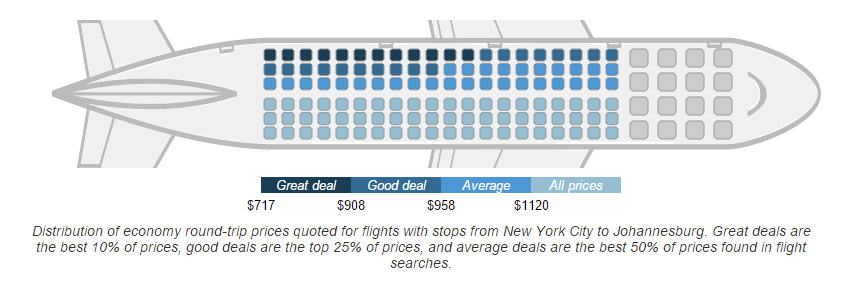
To fare prices in the upcoming months on the more user-friendly and fully-colored webpage:
To route share by carrier (!) back on the technical report:
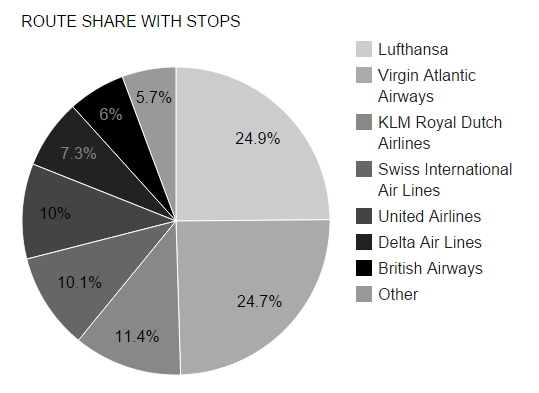
To things as minute as price fluctuations versus day of the week, which shares insight into the best days to buy and fly:

And if these fancy graphics weren’t enough, Hopper hits you with text blurbs to inform your fare-buying patterns in the technical report:

That are confirmed in a concise one-line recommendation on the HTML page:

And of course, what fare recommendation would be complete without options for booking?

In short, “Reports” puts an incredible amount of detailed and automatically-generated fare data at your fingertips. Hopper even does a lot of the basic analysis for you, providing Kayak-like price change insights on when to buy – along with the demand information to back it.
When you consider that Hopper closes the loop by sending you to the airline’s site for booking, it’s clear that no consumer-facing travel site on the market today can match Hopper’s information mining capabilities – and its willingness to make this data so easily accessible.
That being said, Hopper is far from perfect. I encountered several bugs even in the brief time I played around the system. While these flaws pale in comparison to Hopper’s greater “structured database” and the possibilities that accompany it, they will certainly need to be addressed in the near future if Hopper hopes to establish itself as a reliable airfare aggregator (if that is, in fact, what Hopper wants to be).
And when it comes to actually being alerted about low fares, I still prefer feeding RSS-enabled sources (e.g., The Flight Deal, FT Mileage Run Deals) through IFTTT to push notifications to my email. That way, I get real-time and targeted fare results, as opposed to a generic daily subscription email.
But I’d bet Hopper’s sheer data-processing power, masked in a deceptively simple-to-use interface, will pave the way for broad consumer and enterprise appeal. Whether it’s a first-time traveler comparing airline fees to the more hardcore data-enthusiasts building on the company’s extensive data trove, Hopper is sure to change how we buy airfare – and perhaps even think about air travel.
It’s certainly one to watch.
TechCrunch: Why Hopper took so long to “launch”
Betakit on Hopper’s soft launch in 2013
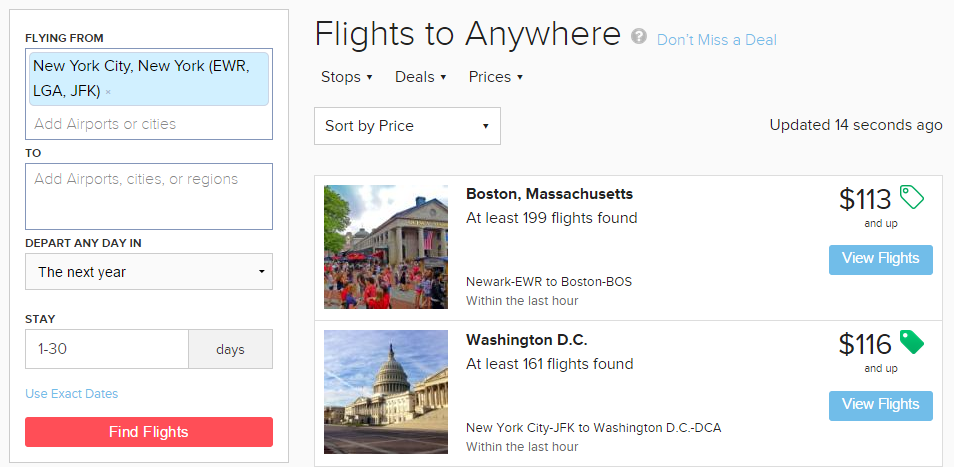

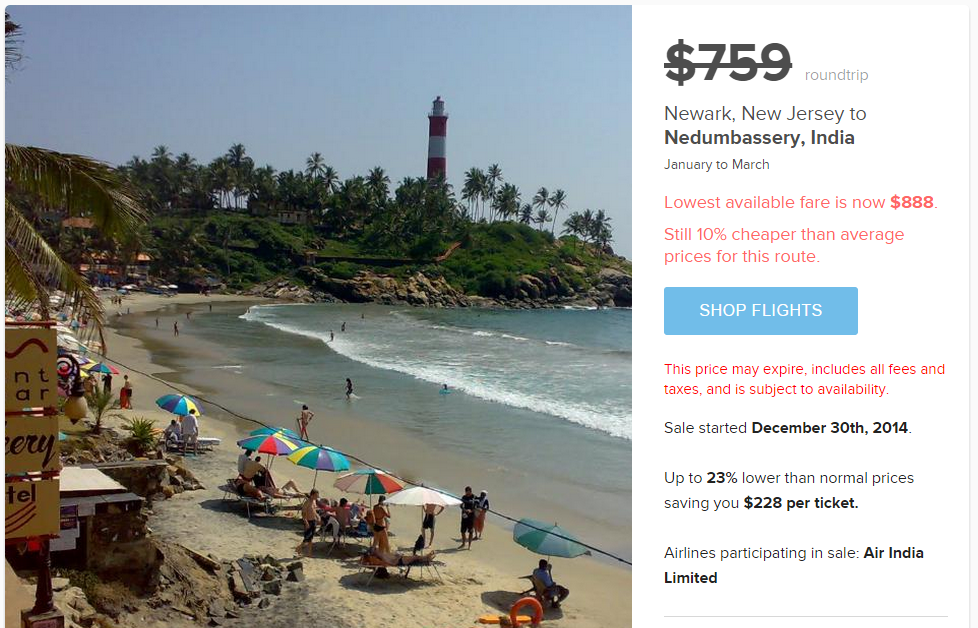

This is awesome!